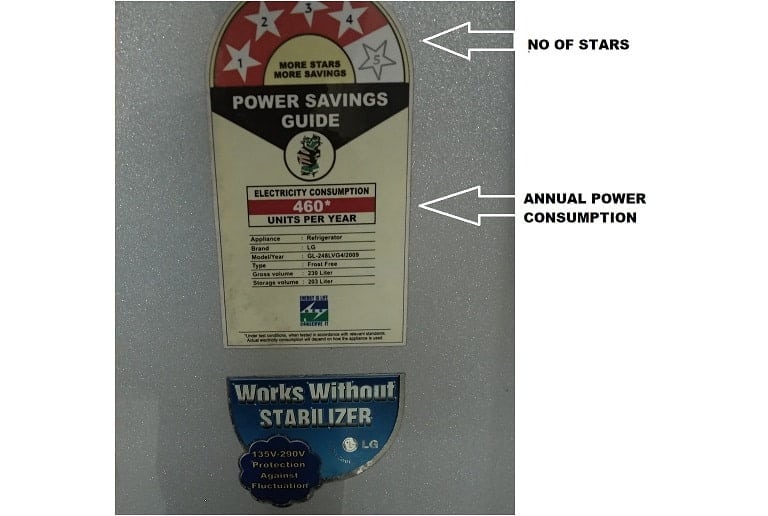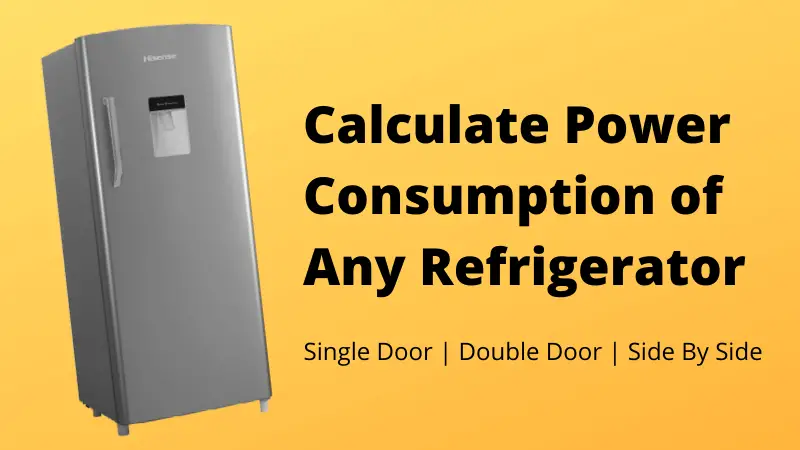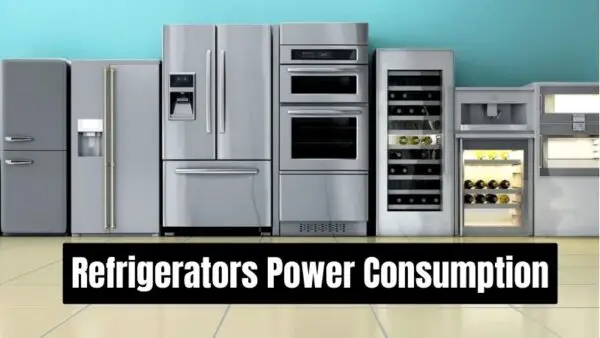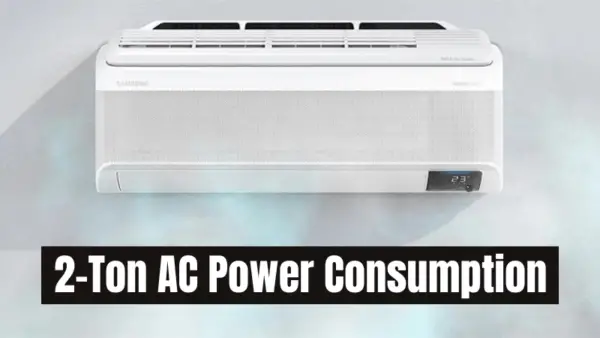Refrigerators are one of the most common household appliances that are used to preserve food. Most refrigerators also come with a built-in freezer box for freezing food. Modern refrigerators are very energy efficient compared to older models from a few decades ago. A fridge will use anywhere from 100 watt to 400 watt depending on it’s size.
If you have a BEE rated refrigerator then you can see it’s power consumption on the BEE sticker itself. The below image shows that the annual power consumption of my 230 liter LG refrigerator is 460 kWh.

To use the refrigerator power consumption calculator to calculate the power consumption of your refrigerator and interpret the results correctly you should understand the following terms.
If you know these terms then feel free to scroll down to use the refrigerator power consumption calculator.
- What is Watt (W) – Watt is a unit of power. It means the rate at which electricity is consumed or produced by a device. For example a 250 watt refrigerator consumes power at a rate of 150 watts per hour, it does not mean that the refrigerator consumed 250 units of electricity, it means it will consume power at a rate of 250 watts every hour.
- What is Kilowatt (kW) – Kilowatt is also a unit of power. Kilowatt (KW) is used for large devices that consume more power. For example a 1.5 kW air conditioner, 6 kW elevator. There are bigger units like Megawatt (MW), Gigawatt (GW) to describe large power consumption or generation. For example 100 Megawatt (MW) coal power plant.(1 kW = 1000 W)
- What is a Kilowatt hour (kWh) – Units as described in electricity bill a.k.a kilowatt hour is the energy consumption of a device. For example a 50 watt Television (TV) running for 50 hours will consume 50 watt x 50 hours = 2500 watt hours = 2.5 kilowatt hours of electricity = 2.5 units of electricity. (1 kWh of electricity = 1 unit of electricity)
- Electricity Tariff – Electricity tariff is the amount the electricity provider charges you for one unit (kWh) of electricity. I live in Mumbai, India here the electricity tariff is Rs 12/kWh. If you don’t know how to calculate your tariff then just divide your total bill by monthly power consumption and you will get your electricity tariff.
- What is operational hours – Operational hours of a device refers to the number of hours the device is working. If you run your television for 3 hours then operational hours of your television is 3 hours.
To calculate the power consumption of your refrigerator just input the rated power of your refrigerator, operation hours of your refrigerator (most cases 24) and the electricity tariff in your place.
If you don’t know your refrigerator rated power then just search your fridge or similar size fridge on amazon and check it’s wattage in product description.
If you don’t want to do this, then just take a value between 100 watts to 300 watts as most refrigerator has rated power around this.
How To Interpret Results:
The values obtained from the calculator will be almost twice the actual values since the compressor of most regular refrigerator turns on and off depending on the cooling needs. On an average a refrigerator compressor duty cycle is 50 % which means 50 % of the time the compressor is off.
So divide your final answer by 2 and that should be your refrigerator’s actual power consumption and corresponding electricity bill.
If you have a inverter refrigerator then your refrigerator power consumption would be further less. You can read more on inverter refrigerator in this article – What are inverter refrigerators?
Table of Contents
ToggleTips To Reduce Refrigerator Power Consumption:
- Keep the refrigerator full – This sounds bizarre but keeping your refrigerator full helps to cut down the power consumption. By full refrigerator I don’t mean to over stuff the refrigerator always keep place for proper air circulation.
- Optimize temperature settings – Most of the refrigerator are running at temperature way below what’s needed. On an average temperature of 2 C to 5 C is ideal for fridge compartment and for freezer anything between -10 C to -15 C is good. Don’t overdo the temperature. If you don’t have a thermometer to measure the temperature then just switch your refrigerator setting to normal in normal days and below normal in cold days (use the regulator inside your refrigerator).
- Keep refrigerator door closed – Frequent opening and closing of refrigerator door puts unnecessary load on the compressor to cool the fresh warm air that enters the space every time you open the door. If you cut down your door opening frequency you will see a cut in your electricity bill.
- Place refrigerator strategically – Two questions your should ask yourself before finalizing your refrigerator place. First, is the place getting direct sunlight?, if yes then look for some other place or restrict the sunlight coming to that place by some means. Second, after placing the refrigerator is there any space between the refrigerator walls and your house wall? Ideally you should keep 6 inches of space on all the three side for proper ventilation. You can check out this awesome article from Samsung on how to place your refrigerator How much free space should I allow around my refrigerator?
- Lifestyle changes – Do not keep hot food directly in the refrigerator. First let the food cool down and then put it in the refrigerator. Periodically clean the evaporator and condenser coils. Keep your food organised so that there is enough space for free movement of air.
Check out related blogs on Refrigerator Power Consumption:
Why My Electricity Bill Is So High And How To Rectify It.
Share the articleYou get a message from your electricity provider...
Read More







